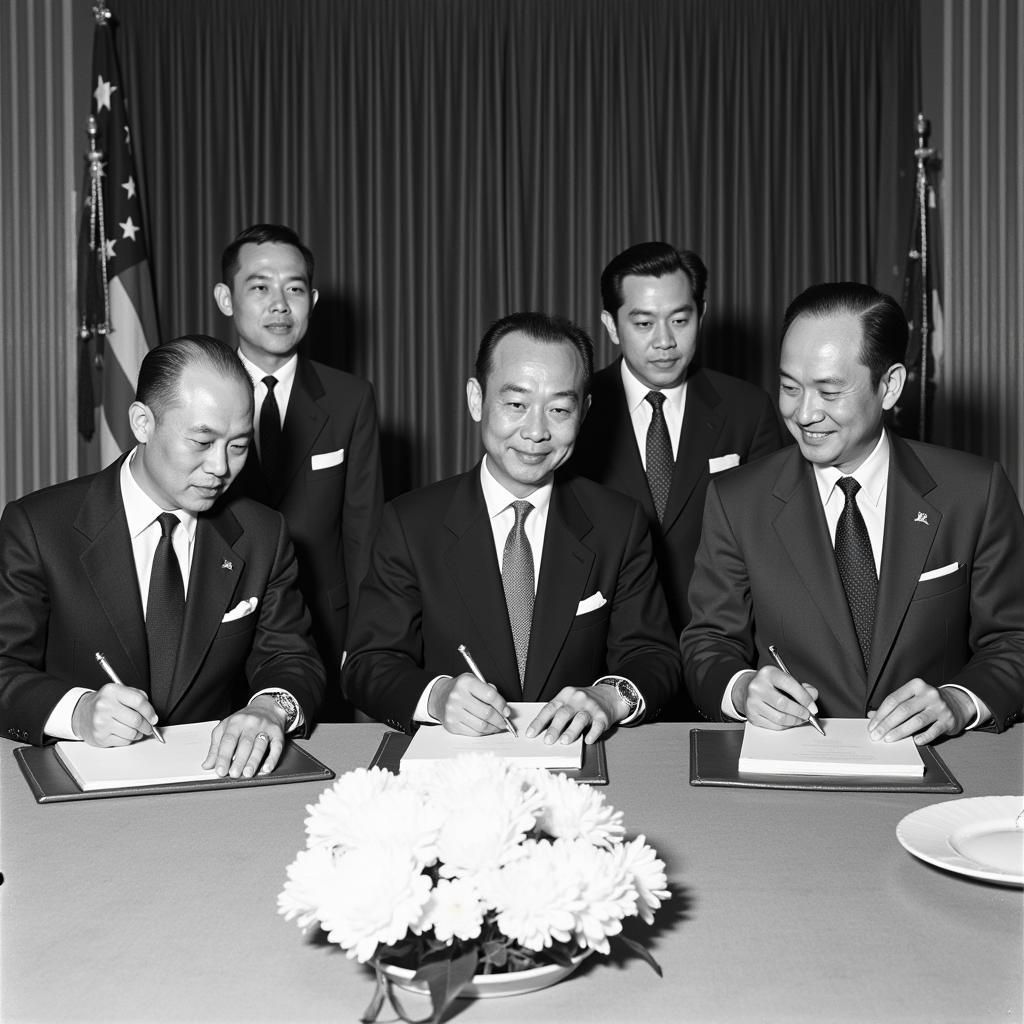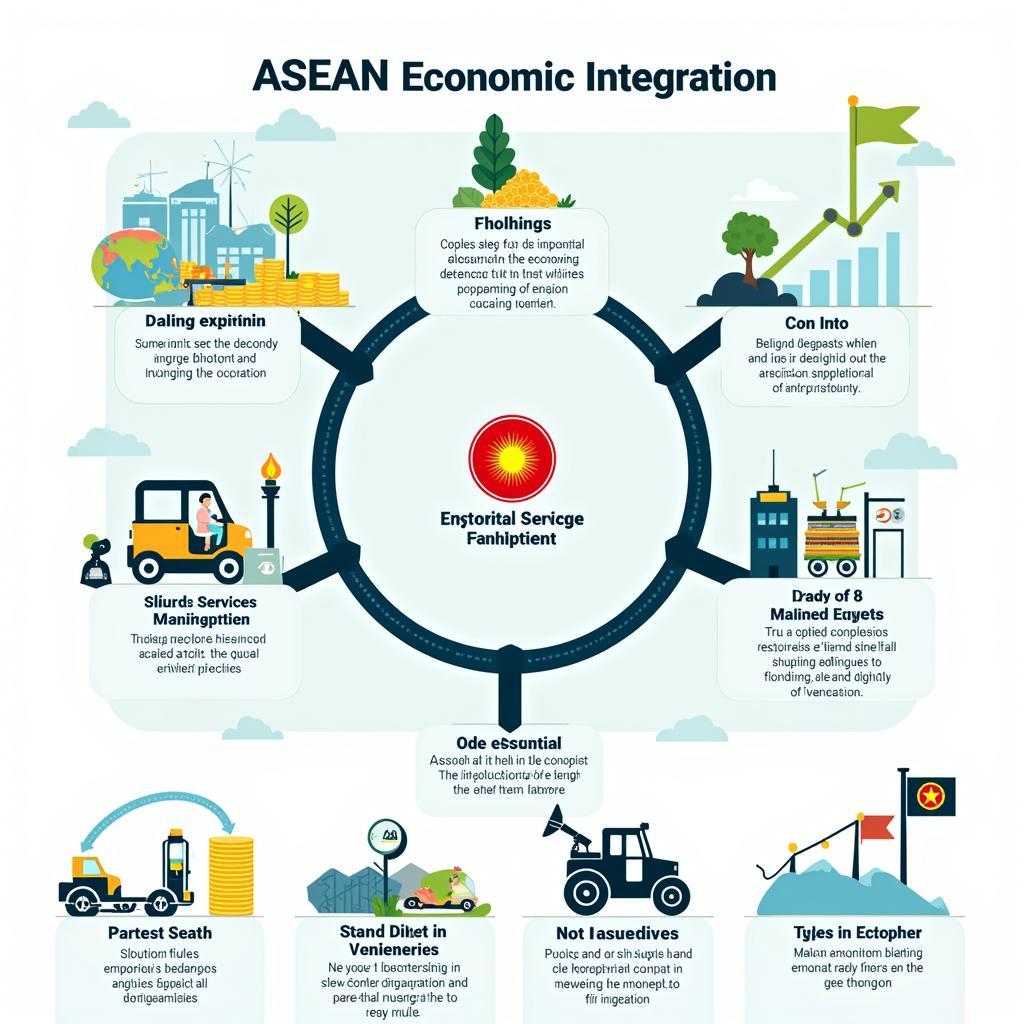The Association of Southeast Asian Nations (ASEAN) has been a cornerstone of regional cooperation and economic growth since its inception. Central to this success are the Asean Agreements, a complex web of treaties, protocols, and declarations that shape the political, economic, and socio-cultural landscape of the region.
A Legacy of Cooperation: Understanding the Foundation of ASEAN Agreements
The ASEAN agreements are not a single entity but rather a constantly evolving framework designed to foster unity and collaboration among member states. From the very beginning, the 1967 Bangkok Declaration laid the groundwork for a Southeast Asia free from conflict, committed to shared prosperity, and open to global engagement.
 ASEAN Founding Fathers
ASEAN Founding Fathers
Key Pillars of Integration: Delving into the Core ASEAN Agreements
To grasp the breadth of these agreements, it’s helpful to categorize them into three main pillars:
1. The Political-Security Community: This pillar focuses on promoting peace, stability, and dialogue within the region. Key agreements include the Treaty of Amity and Cooperation in Southeast Asia (TAC), the Zone of Peace, Freedom and Neutrality (ZOPFAN) Declaration, and the Southeast Asia Nuclear-Weapon-Free Zone (SEANWFZ) Treaty. These agreements provide mechanisms for peaceful conflict resolution, regional security cooperation, and a commitment to nuclear non-proliferation.
2. The Economic Community: Aiming to create a single market and production base, this pillar is anchored by the ASEAN Free Trade Area (AFTA), the ASEAN Framework Agreement on Services (AFAS), and the ASEAN Comprehensive Investment Agreement (ACIA). These agreements work in tandem to reduce trade barriers, facilitate the free flow of goods, services, and investments, and enhance the region’s competitiveness in the global marketplace.
 ASEAN Economic Integration
ASEAN Economic Integration
3. The Socio-Cultural Community: This pillar aims to bridge cultural differences, promote people-to-people connectivity, and foster a shared ASEAN identity. Key agreements include the ASEAN Declaration on Culture and Arts, the ASEAN Tourism Agreement, and the ASEAN Declaration on the Protection and Promotion of the Rights of Migrant Workers. These agreements encourage cultural exchange, promote tourism, and aim to improve the lives of migrant workers within the region.
Navigating the Complexities: Addressing Challenges and Embracing Opportunities
While the ASEAN agreements have undoubtedly driven significant progress, the path towards deeper integration is not without its hurdles.
- Implementation and Enforcement: Translating ambitious goals into tangible results requires effective implementation and enforcement mechanisms at the national level.
- Non-Tariff Barriers: While tariffs have been significantly reduced, non-tariff barriers like differing regulations and standards continue to pose challenges to seamless trade.
- Development Gaps: Addressing the significant development disparities among member states remains crucial for inclusive and sustainable growth.
Despite these challenges, the future of ASEAN agreements holds immense potential. Emerging trends, such as the rise of the digital economy, the growing importance of sustainability, and the need for enhanced connectivity, present new avenues for cooperation and integration.
Looking Ahead: The Evolving Landscape of ASEAN Agreements
The ASEAN agreements represent a dynamic and evolving framework for regional cooperation. As ASEAN navigates a rapidly changing global landscape, these agreements will continue to adapt and evolve to meet new challenges and seize emerging opportunities. By deepening integration, strengthening implementation, and embracing innovation, ASEAN can leverage these agreements to build a more prosperous, sustainable, and resilient future for its people.
FAQs about ASEAN Agreements
1. What is the significance of ASEAN agreements for businesses operating in the region?
ASEAN agreements provide a framework for reduced trade barriers, simplified investment procedures, and greater market access for businesses operating within the region.
2. How do ASEAN agreements impact the lives of ordinary citizens?
These agreements contribute to economic growth, job creation, and improved living standards. They also facilitate travel, cultural exchange, and greater people-to-people connectivity within the region.
3. What role do ASEAN agreements play in addressing regional security concerns?
ASEAN agreements provide mechanisms for dialogue, confidence-building measures, and cooperation on transnational issues such as terrorism, maritime security, and disaster management.
4. How can I stay updated on the latest developments related to ASEAN agreements?
The ASEAN Secretariat website, along with various think tanks and research institutions specializing in Southeast Asian affairs, provide regular updates and analysis on ASEAN agreements.
5. What are some examples of successful initiatives stemming from ASEAN agreements?
The establishment of the ASEAN Single Aviation Market (ASAM), the launch of the ASEAN Economic Community (AEC) Blueprint 2025, and the ongoing efforts to establish an ASEAN digital single market are notable examples of successful initiatives driven by ASEAN agreements.
Do you have any other questions about ASEAN Agreements?
This article only scratches the surface of this complex and important topic. For more information on specific ASEAN agreements, their impact on different sectors, or any other related queries, you can find additional resources on our website:
- ASE Echocardiogram Conference
- ASE Master Certification
- ASE Cardiomyopathy
- ASE Guidelines Endocarditis
- ASE Guidelines 2018
We encourage you to explore these resources and deepen your understanding of how ASEAN agreements are shaping the future of Southeast Asia.
Need further assistance?
Contact us at:
Phone: 0369020373
Email: [email protected]
Address: Thon Ngoc Lien, Hiep Hoa, Bac Giang, Vietnam
Our dedicated customer support team is available 24/7 to assist you.
